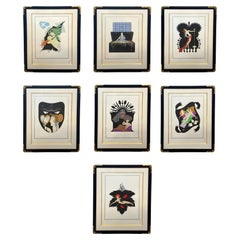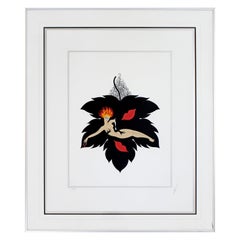Erte 7 Deadly Sins
Vintage 1980s French Prints
Glass, Wood, Paper
Recent Sales
Vintage 1980s French Prints
Paper
People Also Browsed
20th Century Art Deco Figurative Prints
Lithograph
Vintage 1970s French Hollywood Regency Posters
Paper
1980s Art Deco Figurative Prints
Foil
1980s Art Deco Figurative Prints
Screen
Mid-20th Century Paintings
Lacquer
1980s Art Deco Figurative Prints
Foil
Vintage 1970s French Prints
Glass, Wood, Paper
Erté for sale on 1stDibs
Born Romain de Tirtoff (1892–1990) in St. Petersburg, Russia, to an aristocratic family, the artist known as Erté — a pseudonym derived from the French pronunciation of his initials — was a Renaissance man of the art and design world. He worked in graphic arts, interior design, fashion, jewelry and set design for the stage and silver screen, becoming a leader of the Art Deco style.
Moving to Paris in 1912, Erté worked as a fashion designer under couturier Paul Poiret before securing a job with Harper’s Bazaar as a cover artist. Over 22 years, Erté created more than 240 magazine covers alongside his ongoing work in fashion design.
Extending his prolific career into theater sets, costumes, prints and lithographs, Erté became one of the most famous artists of the era. His style — a combination of the nature-inspired flourishes of Art Nouveau and bold, geometric linework — directly contributed to the birth of Art Deco, earning him the nickname “the Father of Art Deco.”
After a lull of creative production in the 1940s and 1950s, Erté reentered the public eye in the 1960s, when a renewed interest in Art Deco had taken shape.
Creating colorful lithographs, bold serigraphs (silk-screen prints) and bronze sculptures, he contributed to a resurgence of the style in France and beyond. This late-life acclaim for his art led to exhibitions in museums and galleries all over the world as well as his first published monograph in 1970. That same year he was awarded the title of Chevalier du Mérite Artistique et Cultural and in 1976 was named Officier des Arts et Lettres by the French government.
Today, Erté’s works are in the collections of the Metropolitan Museum of Art and the Cooper Hewitt, Smithsonian Design Museum, in New York, the Victoria and Albert Museum in London and LACMA in Los Angeles.
On 1stDibs, browse a collection of Erté art, including fine art prints, paintings and other works.
Finding the Right Prints for You
Prints are works of art produced in multiple editions. Though several copies of a specific artwork can exist, collectors consider antique and vintage prints originals when they have been manually created by the artist or are “impressions” that are part of the artist’s intent for the work.
Modern artists use a range of printmaking techniques to produce different types of prints such as relief, intaglio and planographic. Relief prints are created by cutting away a printing surface to leave only a design. Ink or paint is applied to the raised parts of the surface, and it is used to stamp or press the design onto paper or another surface. Relief prints include woodcuts, linocuts and engravings.
Intaglio prints are the opposite of relief prints in that they are incised into the printing surface. The artist cuts the design into a block, plate or other material and then coats it with ink before wiping off the surface and transferring the design to paper through tremendous pressure. Intaglio prints have plate marks showing the impression of the original block or plate as it was pressed onto the paper.
Artists create planographic prints by drawing a design on a stone or metal plate using a grease crayon. The plate is washed with water, then ink is spread over the plate and it adheres to the grease markings. The image is then stamped on paper to make prints.
All of these printmaking methods have an intricate process, although each can usually transfer only one color of ink. Artists use separate plates or blocks for multiple colors, and together these create one finished work of art.
Find prints ranging from the 18th- and 19th-century bird illustrations by J.C. Sepp to mid-century modern prints, as well as numerous other antique and vintage prints at 1stDibs. Browse the collection today and read about how to arrange wall art in your space.

